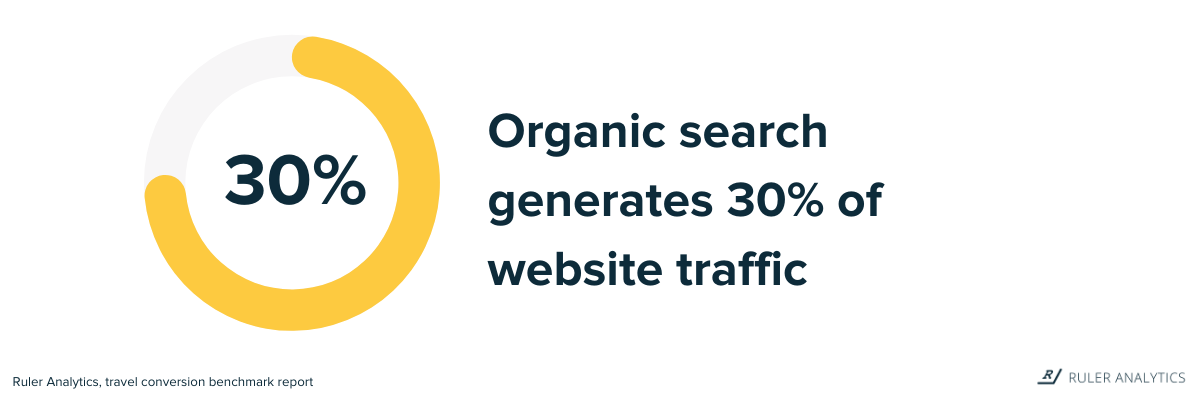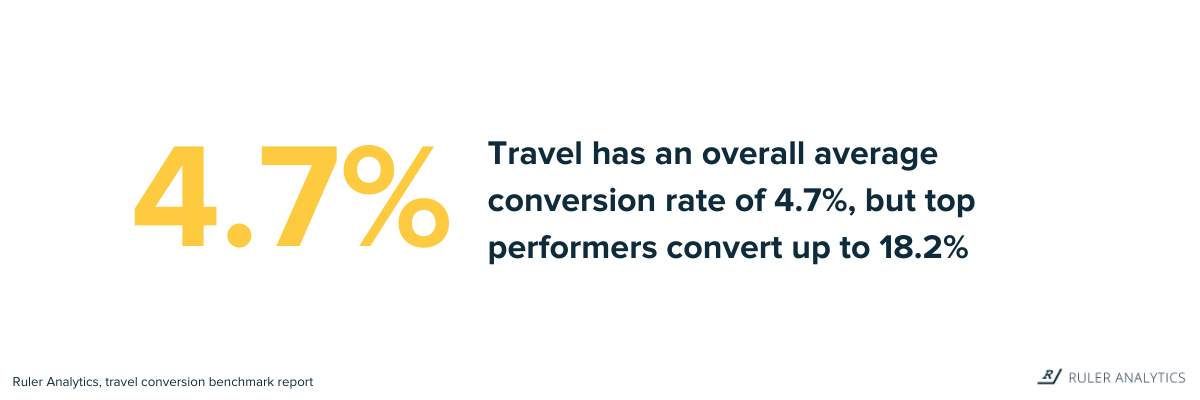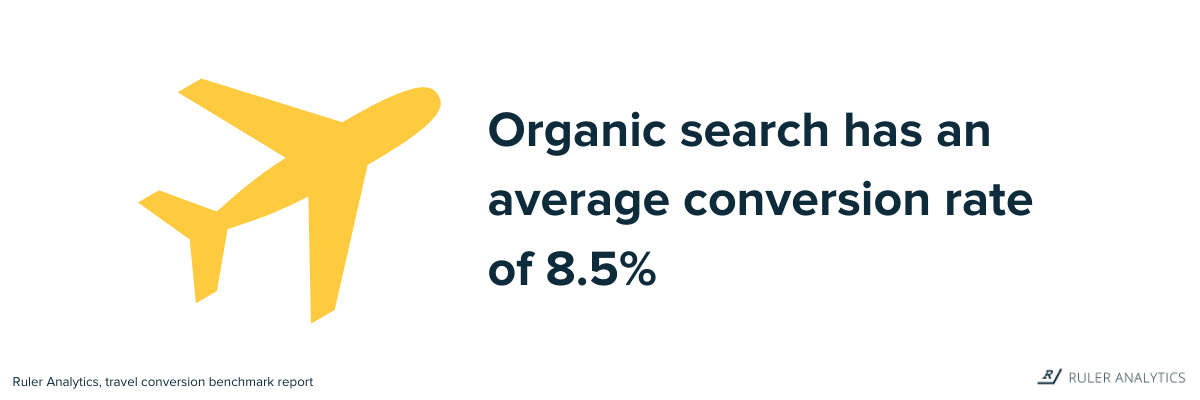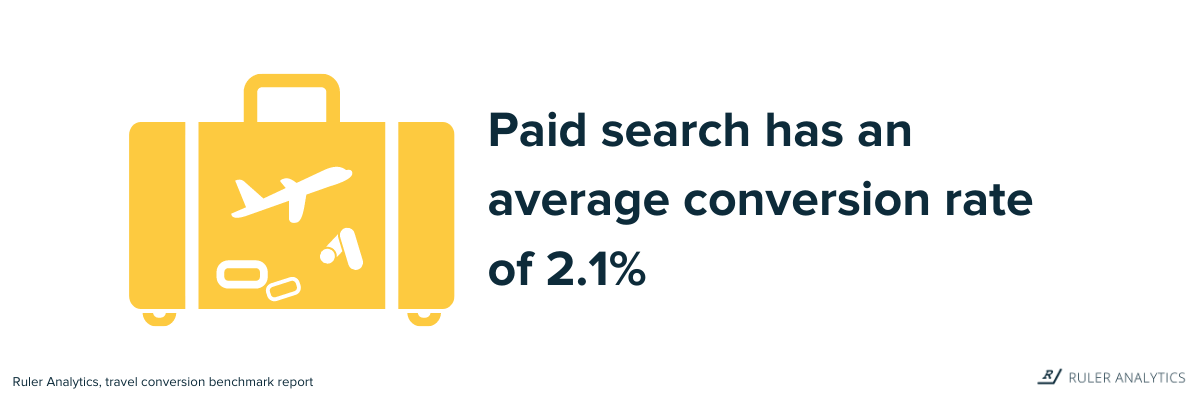Benchmark your performance against other businesses in the travel industry and get more value for your money with these marketing stats and insights.
The travel and tourism sector has had a vast digital transformation over the last few years.
Gone are the days where your only option to book a holiday or trip was to pop into your nearest travel agent.
The modern traveller is more digitally-driven, independent and demanding than ever before, and travel marketers are utilising digital advertising to appeal to a wider audience and stay engaged with prospective holidaymakers.
At Ruler, we work with many travel brands around the world. We help them attribute sales across multiple channels—both online and offline—so that they can optimise marketing for greater ROI.
With that in mind, we decided to capture and collate millions of data points in the Ruler database to round up the most important and valuable statistics and help other travel brands get more out of their marketing.
Here’s what we found!
💡 Pro Tip
Haven’t got time to read the full blog? You can find all of these statistics and more in our conversion rate benchmark report for travel marketers. Get key insights about the travel industry and boost your customer acquisition performance.
Download the travel conversion rate benchmark report
For this study, we sampled the Ruler global database to measure the impact of different marketing channels on traffic and conversions.
The purpose of this guide is to provide travel marketers with valuable insights and help them become better equipped when adjusting budgets towards more cost-effective solutions. Here are some of our major findings.
1. On average, organic search drives 30.7% of website traffic
Organic search is essential for online visibility and is often the first touchpoint in the customer journey. Holidaymakers will turn to Google to compare flights, hotels and package deals all from the comfort of their own home.

2. 19.6% of website traffic comes from paid search
PPC is key since it is highly targeted and allows marketers to get to the top of Google in the matter of a few clicks. Marketers in the travel industry have recognised this as an opportunity, and many are leveraging paid search to reach the right type of audience and boost holiday bookings.
3. We found that 85% of conversions happen online but 15% of conversions are made over the phone
Despite the exponential growth in online bookings, inbound phone calls remain one of the most important conversion types. When it comes to higher-value bookings, people will often prefer to speak with a rep over the phone or in-store to ensure that they’re getting the most value for their money.
💡 Pro Tip
Without call tracking, you potentially underestimating—or overestimating—the effectiveness of your marketing performance. Get your guide on offline conversion tracking and see which marketing sources, keywords and ads are driving the most offline interactions.
Download the offline conversion tracking guide
4. Travel has an overall average conversion rate of 4.7%, but top performers convert up to 18.2%
Marketing in the travel and tourism industry is tough, but some have made it seem easy. We found that top performers in the travel industry were converting at a rate of 23%. Most brands, however, are achieving an average conversion rate of 4.7%.

5. Referral has an average conversion rate of 9.5%
In terms of conversion rate by channel, standing head and shoulders above the rest is referral. Given that 90% of travellers say they are influenced by reviews online, we’re not surprised that word of mouth and referral came out on top as the most trusted source of traffic and conversions.
6. Organic search has an average conversion rate of 8.5%
Closely behind referral is organic search. SEO is a key driver of conversions and is a top priority for marketers in the travel industry. According to research, 90% of people do all their holiday research online and usually start 12 weeks before a trip.

7. Email has an average conversion rate of 4.7%
Email has a lot to offer travel marketers. According to Mailchimp, the average open rate in the travel and tourism industry is 20.44%. Email marketing is the best at sending personalised messages and offers to help engage new and existing customers.
8. Paid search has an average conversion rate of 3.6%
Paid search allows travel marketers to attract the interest of holidaymakers who are ready to book their dream destination. Higher value packages and deals are harder to convert as buyers generally need more time and reassurance to commit. So, just because the conversion rate for paid search is lower doesn’t mean it’s not influencing your bottom line.
💡 Pro Tip
Closed-loop marketing allows you to go beyond cost per lead metrics to identify the marketing activities that generate the most (and the least) revenue. Get your copy of the closed-loop marketing attribution guide and learn more about the possibilities.
Download the closed-loop marketing guide
9. Paid social has an average conversion rate of 2.1%
While paid social has the lowest conversion rate, it does have its benefits. Social media is a great way to capture the attention of a local audience and is a great place for your existing and previous customers to share their positive thoughts and experiences. (Source: Ruler Analytics)

Taking these statistics into consideration, we’ve identified key trends and takeaways every travel marketer should keep at the top of their mind when making strategic decisions about where to invest for the future.
Without a doubt, travel was the hardest hit sector during the COVID-19 pandemic. Travel was brought to a halt, and many brands were forced to shut down. In fact, 90% of global travel marketers dramatically reduced their marketing budgets due to the pandemic.
Following the travel restrictions, the demand for UK staycations increased to a record level. According to research, Google UK searches for “staycation” increased by over 500% in July 2020 compared to the previous summer. Whereas UK searches for ‘cheap flights’, ‘train tickets’ and ‘cruise holiday’ hit an all time low.
In response to the pandemic and shift in consumer behaviours, many marketers turned towards hyperlocal content and SEO to drive a renewed interest closer to home.
For now, the UK staycation is here to stay. Although, with the slow reopening of the hospitality and travel sector across the world, holidaymakers are starting to perform searches further afield. Since January 1, 2021, Google searches are up 92% for hotels, 79% for flights, and 88% for cruises.
Also, when asked what type of holiday they expect to take in the next 12 months, 38% of UK respondents said they’re expecting to take a domestic holiday.
So, while the interest in staycations isn’t showing any signs of slowing down, it’s important that SEO marketers are capturing the attention of holidaymakers performing more searches related to domestic travel in the wake of the lifted restrictions and vaccine rollout.
While SEO is a cost-effective and more sustainable tactic, it’s not an overnight success. One of the main benefits of PPC is that it provides immediate results.
Also, paid advertising is extremely targeted and does well at capturing the attention of people at the bottom of the sales funnel who are ready to commit to a trip or holiday destination.
There’s a wide selection of paid advertising platforms to choose from, more than ever before. However, if you’re in 78% of companies that cut down paid media spending due to the pandemic, chances are you’re feeling a little uneasy about investing in paid media in case it doesn’t render any results.
But without PPC, you’re essentially giving away qualified traffic and leads to your competitors.
Google Ads, Facebook, Instagram all have their strengths, but you should select the PPC platforms you use by asking yourself one important question: Where will I get the biggest ROI from my advertising spend?
Related: How to track and measure your PPC ROI
This can be a difficult question to answer, especially when your only option to track paid media performance is using goal tracking in Google Analytics and Ad platforms. Marketing attribution tools like Ruler, however, can make the process a whole lot simpler.
Related: How Ruler can help optimise your PPC advertising strategy
Ruler is able to track a customer’s end to end journey, both offline and online, and attribute revenue to campaigns. You can see which channels, campaigns, ads and keywords are contributing most to the customer journey, and more importantly, bottom line.
Travel brands have relied on word of mouth and referrals for decades.
Online referrals play a significant role in the customer journey. One of the first things people will do when planning a trip or holiday is scope out reviews and referrals online.
A referral could be another site recommending your services and linking to you, or it could be a local listings site. Sites such as Trustpilot and Tripadvisor, in particular, offer travel brands social proof that can sway consumer behaviour and booking decisions.
Social media sites have made it easier for people to leave comments about their recent stay and overall experiences booking a trip or holiday.
Developing a strong referral program is key to your lead generation. So, make sure you’re repeatedly asking for referrals from your happy customers.
Whilst form fills convert at a better rate, phone calls still offer a significant opportunity.
In the case of bespoke, premium and luxury travel tours, holidaymakers tend to originate online and close over the phone or in-store. In fact, for 60% of travellers, the first step is placing an online search.
Also, with the uncertainties surrounding the pandemic, cancellation policies and proof of vaccination, a phone call is typically the best way to clear up any concerns and get immediate answers to the most complex questions.
Don’t forget, using an offline attribution solution like Ruler, you can receive a holistic view of the customer journey and track which of your marketing efforts are resulting in the most valuable offline interactions.
Related: How to connect your online and offline marketing and track ROI
There you have it. We encourage you to take advantage of these travel statistics when optimising your marketing strategy for greater results. These stats should guide you towards generating more qualified traffic and sales.
Don’t forget, we have plenty more mind-blowing insights and statistics in our conversion benchmark report for travel marketers.
If you’re looking for more information on how Ruler can transform your lead generation strategy, then we’d love to chat. You can book a demo with one of our sales reps to get started.
This blog was originally published in August 2021 and was last updated on 26th April 2022 for freshness.